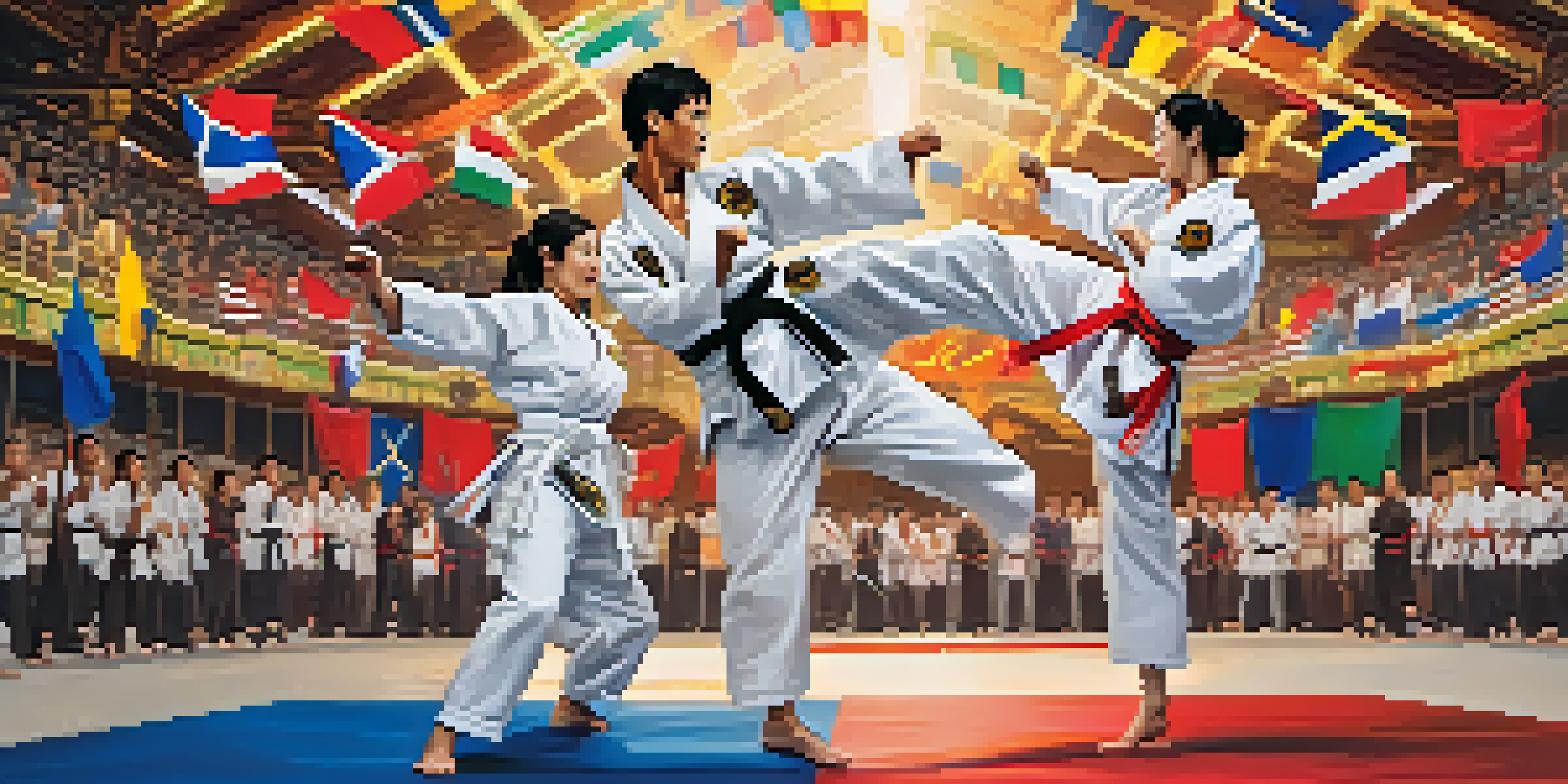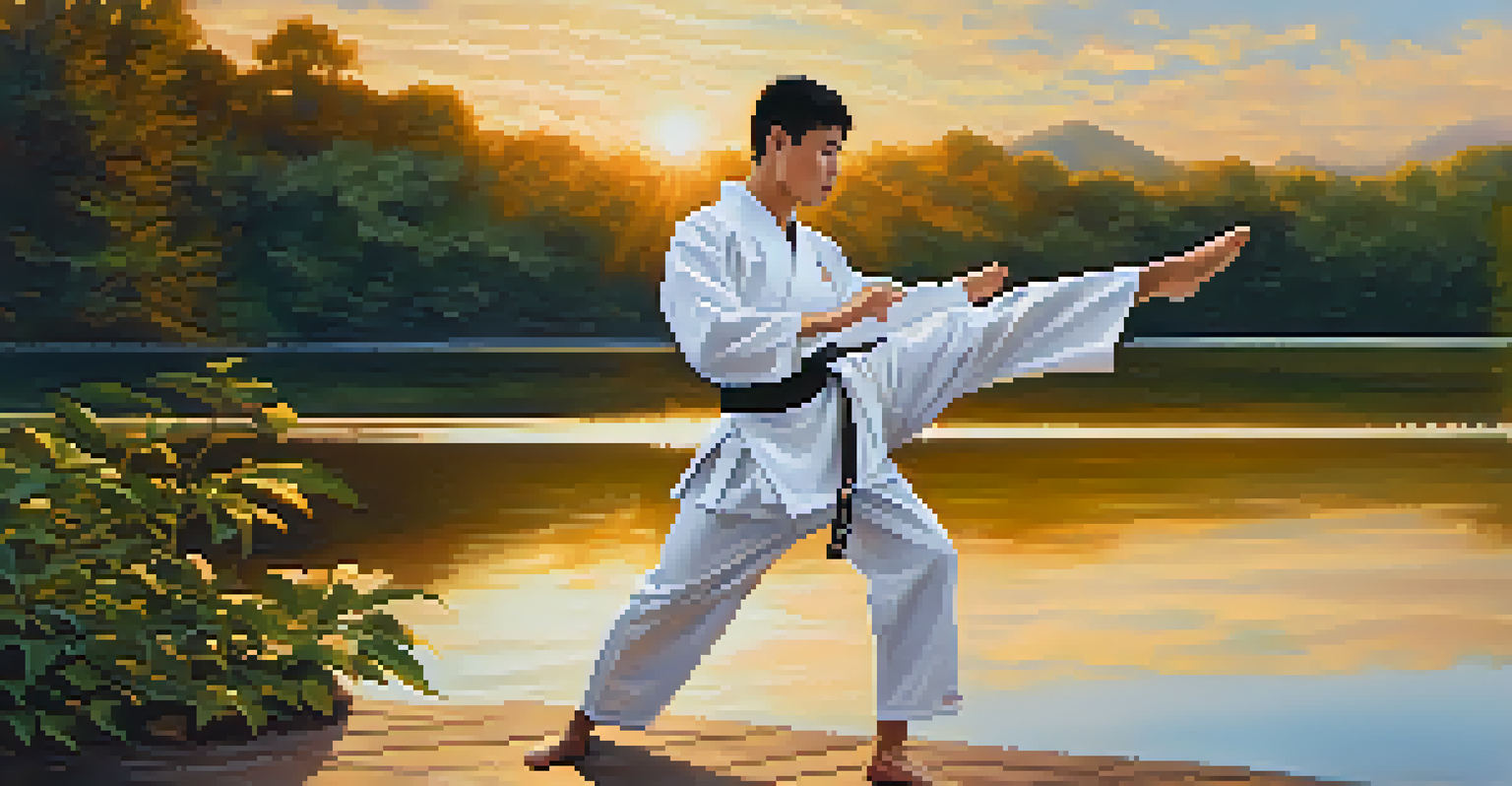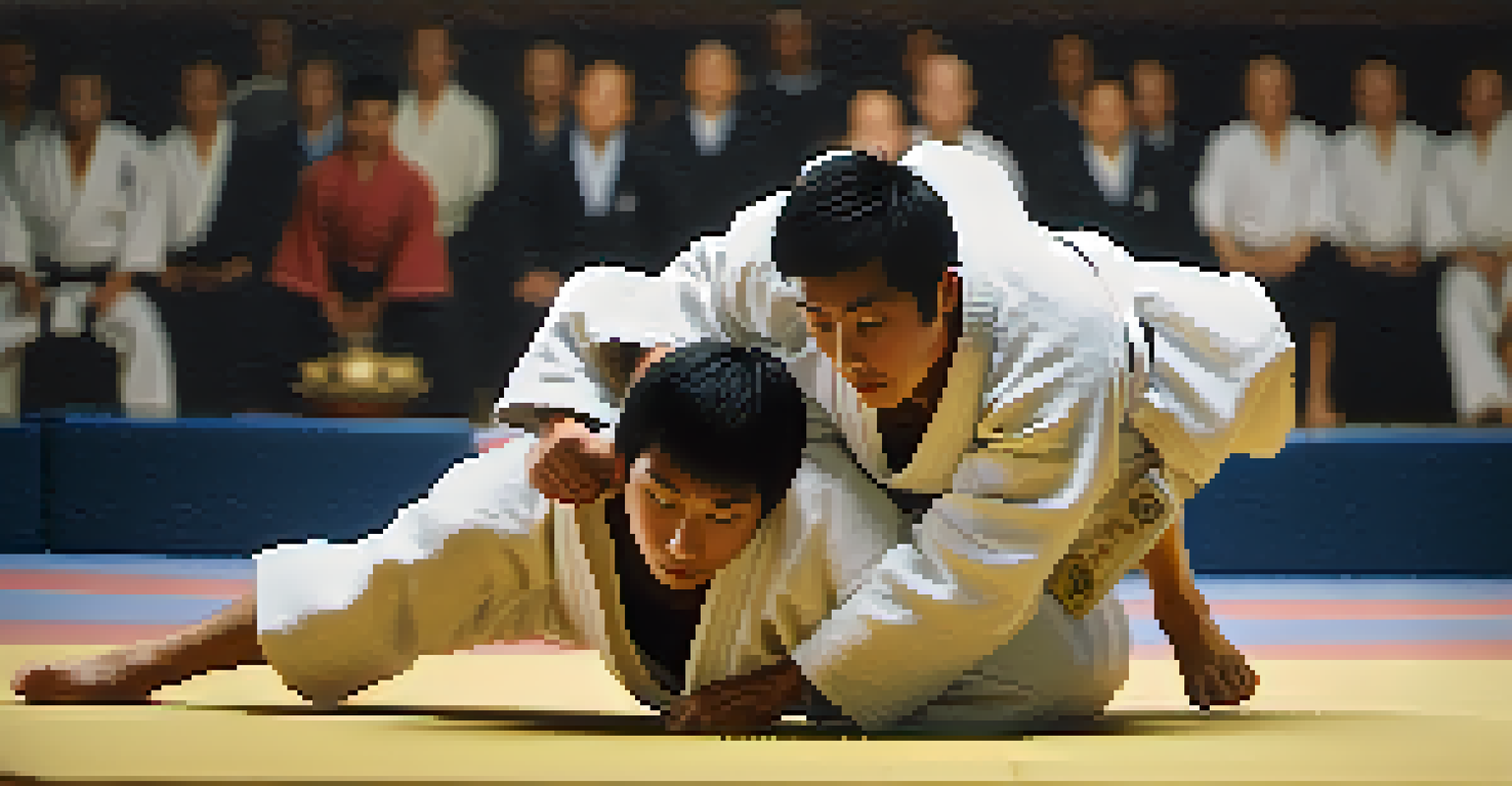Martial Arts Styles Represented in Global Competitions

Overview of Martial Arts in Global Competitions
Martial arts have become a prominent aspect of global sports, showcasing a variety of techniques and philosophies. From the Olympics to world championship events, numerous styles vie for recognition and respect. This rich tapestry of martial arts not only highlights individual techniques but also fosters cultural exchange among practitioners worldwide.
Martial arts is not about the technique itself, but the principles behind the technique.
The inclusion of martial arts in major competitions has helped elevate their visibility and popularity. Athletes train rigorously to represent their countries, contributing to the spirit of international sportsmanship. As viewers, we get to witness the beauty and discipline inherent in these diverse styles, making competitions both thrilling and educational.
Understanding the different martial arts styles represented in these events can enhance our appreciation for the athletes and their skills. Each style brings its own unique flavor, emphasizing different techniques, strategies, and philosophies. In this article, we will delve into some of the most popular martial arts styles showcased in global competitions.
Karate: The Striking Art from Japan
Karate, a well-known martial art originating from Japan, is celebrated for its powerful strikes and dynamic movements. It emphasizes techniques such as punches, kicks, and knee strikes, making it a favorite in various competitions. The sport gained global recognition when it was included in the Olympic Games, showcasing its widespread appeal.

In competitions, karate practitioners are judged on their performance in both kata (forms) and kumite (sparring). Kata allows athletes to demonstrate their skills through choreographed movements, while kumite tests their ability to apply techniques in real-time against an opponent. This combination highlights the versatility and depth of karate as a competitive sport.
Martial Arts Unite Cultures Globally
Martial arts competitions not only showcase diverse techniques but also foster cultural exchange among practitioners worldwide.
Karate's emphasis on discipline and respect mirrors its cultural roots, making it more than just a physical practice. The values instilled in practitioners are reflected in their conduct during competitions, reinforcing the idea that martial arts go beyond mere sport. As karate continues to grow in popularity, its representation in global competitions remains strong.
Taekwondo: The High-Flying Art of South Korea
Taekwondo, known for its spectacular kicks and agility, hails from South Korea and has carved a niche in international competitions. With its focus on head-height kicks and jumping spin kicks, taekwondo captivates audiences and judges alike. This martial art became an Olympic sport in 2000, further solidifying its status on the global stage.
The ultimate aim of martial arts is not having to use them.
Competitions in taekwondo are structured around two main formats: sparring and poomsae (forms). Sparring matches require athletes to score points through controlled kicks and punches, while poomsae emphasizes precision and technique in a series of movements. Together, these formats showcase the breadth of skills required to excel in taekwondo.
The core tenets of taekwondo—courtesy, integrity, perseverance, self-control, and indomitable spirit—play a significant role in shaping the character of its practitioners. This philosophy resonates in competitions, where respect for opponents and officials is paramount. As taekwondo continues to thrive, it remains a vibrant part of the martial arts landscape.
Judo: The Gentle Way of Japan
Judo, which translates to 'the gentle way,' is a Japanese martial art focused on throwing and grappling techniques. It emphasizes using an opponent's force against them, making it a compelling and strategic sport in competitions. Judo gained Olympic status in 1964 and has since attracted a diverse range of practitioners worldwide.
In judo competitions, athletes aim to achieve ippon, a decisive victory that can be scored through throws, pins, or submissions. The dynamic nature of judo matches keeps spectators engaged, as each bout is a test of skill, strategy, and timing. Judokas are trained not only in techniques but also in the principles of respect and humility.
Diverse Styles Elevate Competition
Each martial art, from karate to BJJ, brings unique techniques and philosophies to global competitions, enhancing appreciation for the athletes.
Judo's philosophy promotes physical and mental discipline, encouraging practitioners to develop resilience and confidence. This focus on personal growth is evident in competition settings, where sportsmanship plays a crucial role. As judo continues to evolve, its representation in global events highlights its enduring appeal and significance.
Brazilian Jiu-Jitsu: The Ground Game of Brazil
Brazilian Jiu-Jitsu (BJJ) has gained immense popularity worldwide, especially in mixed martial arts (MMA) competitions. This grappling-based martial art emphasizes ground fighting and submission techniques, allowing smaller practitioners to defend against larger opponents. Its effectiveness in real-world situations has made BJJ a staple in the martial arts community.
In BJJ competitions, athletes compete in various weight classes, showcasing their skills in both gi (uniform) and no-gi formats. The goal is to submit the opponent using various joint locks and chokeholds, which requires a deep understanding of leverage and positioning. This strategic nature of BJJ makes matches fascinating for both participants and spectators.
The core principles of BJJ revolve around fluidity and adaptability, encouraging practitioners to think critically during sparring sessions. The camaraderie among BJJ practitioners fosters a supportive environment, allowing athletes to learn from each other. As BJJ continues to thrive in global competitions, its emphasis on technique and strategy remains at the forefront.
Muay Thai: The Art of Eight Limbs from Thailand
Muay Thai, known as the 'Art of Eight Limbs,' is a striking martial art from Thailand that utilizes punches, kicks, elbows, and knees. Its dynamic and powerful techniques make it a thrilling sport to watch and practice. Muay Thai has gained international attention, especially with the rise of MMA, where its striking techniques are highly valued.
In competitions, Muay Thai fighters are evaluated on their effectiveness in striking, clinch work, and overall strategy. Matches are intense, with athletes demonstrating their resilience and skill in the ring. The sport's rich cultural heritage adds an extra layer of depth, as traditional rituals and customs are often incorporated into competitions.
Future Growth of Martial Arts
The increasing popularity and grassroots engagement in martial arts among youth suggest a promising future for their representation in global competitions.
The discipline and respect ingrained in Muay Thai training contribute to the development of well-rounded athletes. Fighters not only hone their physical abilities but also cultivate mental toughness and sportsmanship. As Muay Thai continues to grow in popularity, its representation in global competitions showcases the beauty and intensity of this remarkable martial art.
Kung Fu: The Diverse Styles of China
Kung Fu, or Wushu, encompasses a wide range of martial arts styles originating from China, each with its unique techniques and philosophies. From graceful movements in Tai Chi to explosive strikes in Wing Chun, Kung Fu offers something for everyone. Its rich history and cultural significance have made it an enduring presence in global competitions.
In competitions, Kung Fu practitioners may participate in forms (taolu) or sparring events, displaying their skills through choreographed sequences or live matches. The diversity of styles within Kung Fu allows athletes to express their individuality while adhering to the foundational principles of the art. This variety keeps audiences captivated as they witness the different interpretations of martial arts.

The emphasis on balance, coordination, and inner strength in Kung Fu training fosters personal growth for its practitioners. Competitions serve as an opportunity for athletes to showcase their hard work while embodying the spirit of respect and humility. As Kung Fu continues to thrive on the global stage, it highlights the beauty of martial arts and their ability to transcend borders.
The Future of Martial Arts in Global Competitions
As martial arts continue to evolve, their representation in global competitions is likely to grow even more diverse. The blending of styles and techniques, especially in the context of MMA, is paving the way for new forms of martial arts that challenge traditional boundaries. This evolution fosters a sense of innovation and creativity among practitioners.
Moreover, the increasing popularity of martial arts among youth is encouraging more athletes to participate in competitions. Schools and academies worldwide are now offering programs that introduce students to various martial arts, fueling interest and participation. This grassroots engagement is crucial for the future of martial arts, ensuring their legacy continues.
In the coming years, we can expect to see more international competitions celebrating the diversity of martial arts styles. This will not only promote cultural exchange but also inspire future generations of martial artists. As we embrace this dynamic landscape, the future of martial arts in global competitions looks bright and promising.